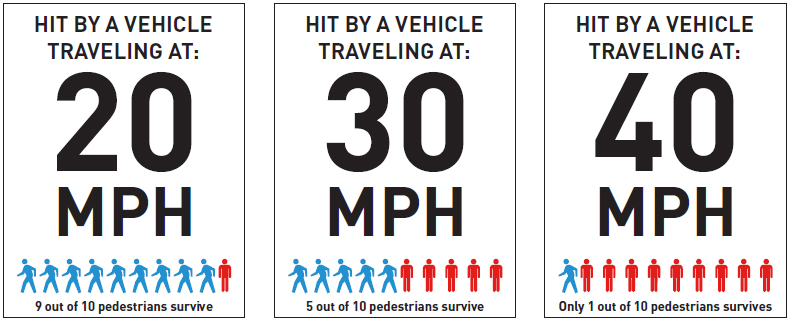In traffic safety, the fastest way to save lives, prevent serious injuries and achieve progress on Vision Zero is to get people driving to slow down.
Speeding and reckless driving are rampant in Chicago, and excessive speed is the most common factor in serious and fatal crashes.
Too many Chicago streets are supersized and thereby encourage drivers to speed. Enforcement is lacking, which results in people frequently driving 10 miles per hour or more above the speed limit, endangering the lives of people inside and outside their vehicles.
About 80 percent of the traffic fatalities and injuries in Metro Chicago are people in cars, and only a small percentage of those incidents happen on highways. The battle for Vision Zero will largely be won on local streets.
While Chicago works to develop a Vision Zero Action Plan, reducing vehicle speeds on city streets must be the top priority. The good news is it’s been proven that even incremental reductions in speed greatly increase the likelihood of avoiding death or serious injury in the event of a crash.
Many cities across the U.S. and around the world have successfully reduced vehicle speeds with changes in policy, street design and enforcement.
Here are some changes Chicago should consider:
- Reducing speed limits: 20 per hour is plenty on city streets. Chicago’s 30 miles per hour speed limit is too high, especially in busy corridors with large numbers of people biking and walking. Chicago should further analyze vehicle speeds and reduce the default speed limit at the citywide or neighborhood level. Recognizing the dangers of high speeds to all road users, Boston, Seattle and New York all recently lowered speed limits. Often this requires changing state policy to allow cities to set their own limits.
- More rightsizing: Although progress has been made in recent years, too many Chicago streets remain designed to move as many cars as possible as quickly as possible. Rightsizing projects that repurpose vehicle travel lanes for biking, waking or transit have proven to make streets safer for all users.Chicago should implement more rightsizing projects on high-crash corridors with excess capacity. While Chicago lacks a dedicated funding source to redesign its highest crash corridors, New York City allocated $115 million in its 2017 budget to Vision Zero capital projects.
- Fair enforcement: Resources for additional in-person enforcement of speeding are limited and the city’s automated speed enforcement program is limited by the number of safety cameras and where they can be placed. Chicago should evaluate the effectiveness of its automated speed enforcement program to maximize its impact on the Vision Zero speed reduction goal.
Without slowing vehicles down, we’ll never make real progress on Vision Zero. Join the fight for slower vehicles and safer streets by signing our call to action.
Learn more about Vision Zero – including our policy recommendations on commercial vehicles and hit and run crashes – on our Vision Zero campaign page.
Graphic Credit: Vision Zero: Safer Streets for Seattle

